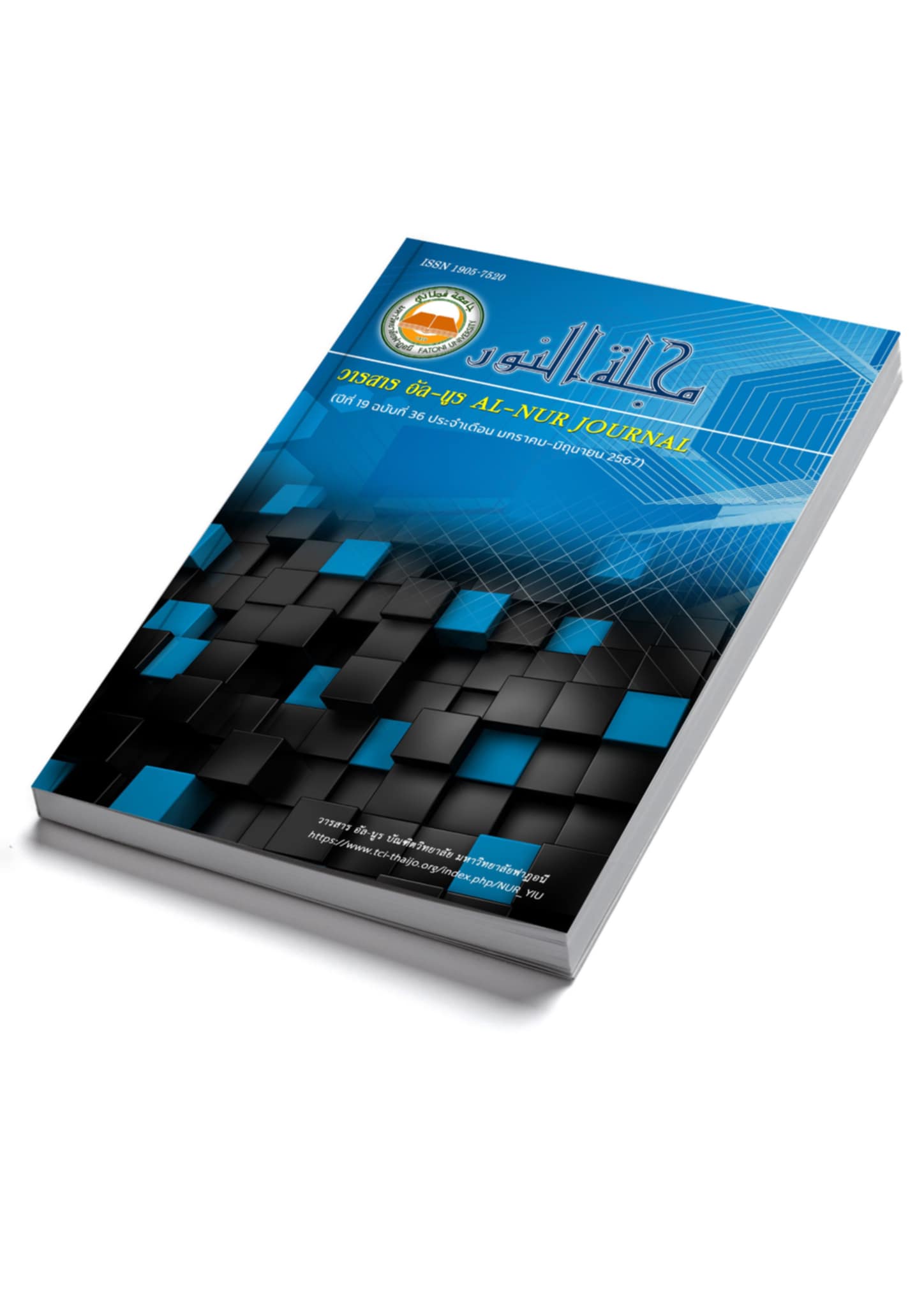Comparison of Jawi Written Malay Words in the Book of Sheikh Daud Al-Fatoni and the Book of Sheikh Ismail Lutfi Fatoni: A Study of Development
Keywords:
Jawi word, book, Sheikh Daud Al-Fatoni, Sheikh Ismail Lutfi FatoniAbstract
Abstract
The word Jawi is a Patani identity that in its development there are word variations. This study aims to explain the similarities and differences between Jawi's words in the book of Sheikh Daud Al-Fatoni and the book of Sheikh Ismail Lutfi Fatoni. The source of the research data is the book Jam’u al-Fawaid wa Jawazir al-Qalaid by Syekh Daud Al-Fatoni and the book Hakikat Al Syaitan Al Rajim by Syekh Ismail Lutfi Fatoni. Data collection techniques are done with reading and recording techniques. The data analysis techniques used are identifying data, grouping data, describing data, and concluding data. The results of the study show that a comparison of Jawi words in the book of Sheikh Daud Al-Fatoni and the book of Sheikh Ismail Lutfi Fatoni has two parts, which are similarities and differences. The similarity part is found to be the similarity of the letter ف dot one for both authors with a different /P/ sound ڤ dot three in Kaedah Ejaan Jawi Fatoni book. The letter ta marbutah for Arabic words is the same for both authors and is in line with Kaedah Ejaan Jawi Fatoni book. Meanwhile, the difference part is found using the letters ta marbutah and ta maftuhah. The letter ta marbutah at the end of the word is used for Arabic absorption words, while the letter ta maftuhah is used in the original Malay language. While the witness letter waw is used for the sound /u/ in the syllables /ku/ and /mu/, while the suffix /i/ in the final syllable /i/ must have a hamzah (ء) before the witness letter /ya/ for the sound /i/.
References
Abdul Rahman, Hamdan. (2014). Panduan Menulis dan Mengeja Jawi Edisi Kedua. Kuala Lumpur: Dewan Bahasa dan Pustaka.
Bradley, F. (2009). Moral Order in a Time of Damnation: The "Hikayat Patani" in Historical Context. Journal of Southeast Asian Studies, 40(2), 267-293.
Chapakiya, Suraiya. (2021a). Kaedah Ejaan Jawi Fatoni. Kuala Lumpur: Dewan Bahasa dan Pustaka.
Chapakiya, Suraiya. (2021b). Perkembangan Tulisan Jawi Sebagai Warisan Bangsa Melayu Patani. 1st International Symposium on Cultural Heritage (ISyCH), hlm. 32-29. Kelantan: Faculty of Creative Technology and Heritage, Universiti Malaysia Kelantan.
Fathy Al-Fatani, A. (2012). Dilema Basa Yawi di Selatan Thai: Antara Kesetiaan Bahasa dan Cabaran Semasa. Jurnal Melayu (9), 99-112.
Fatoni, Ismail Lutfi. (2019). Hakikat Al Syaitan Al Rajim. Fatoni: Jamiah Fatoni.
Haji Musa, Hashim. (2003). Sejarah Sistem Tulisan dalam Bahasa Melayu. Kuala Lumpur: Dewan Bahasa dan Pustaka.
Islahuddin, Tawandorloh, K., & Chema, A. (2020a). Konflik Sosial dalam Hikayat Patani. Stilistika: Jurnal Pendidikan Bahasa dan Sastra, 13(2), 198–215. DOI: http://dx.doi.org/10.30651/st.v13i2.5026.
Islahuddin, Tawandorloh, K., Hama, R., & Chapakia, F. (2020b). Transformasi dalam Novel Ratu-Ratu Patani Karya Isma Ae Mohamad: Kajian Intertekstual Julia Kristeva. BAHASTRA, 40(1), 20-28. DOI: http://dx.doi.org/10.26555/bahastra.v40i1.14960.
Kamaruddin Isaya, Charuwat Song Mueang, Abdulkareem Sameng, dan Harech Chado. (2010). Perkembangan Sistem Tulisan Melayu Patani Menggunakan Tulisan Jawi Pemuliha raan dan Menghidupkan Semula Bahasa dan Budaya Tempatan Kajian Kes: Mukim Khao Tum, Daerah Yarang, Wilayah Pattani. Journal of Language and Culture. Vol. 29 (1), 36-56.
Kang, Kyoung Seock. (1990). Perkembangan Tulisan Jawi dalam Masyarakat Melayu. Kuala Lumpur: Dewan Bahasa dan Pustaka.
Lubis, M., & Kembaren, M. M. (2018). Tulisan Jawi: Jambatan Masa ke Masa Silam dan Usaha Pelestariannya. Rumpun Jurnal Persuratan Melayu. Vol.6(1), 61 - 73.
Matheson, Virginia dan M. B. Hooker. (1988). Jawi Literature in Patani: The Maintenance of an Islamic Tradition. Journal of the Malaysian Branch of the Royal Asiatic Society, Vol. 61(1), pp. 1-86.
Moain, Amat Juhari. (1996). Perancangan Bahasa: Sejarah Aksara Jawi. Kuala Lumpur: Dewan Bahasa dan Pustaka.
Mujani, Wan Kamal. (2002). Minoriti Muslim: Cabaran dan Harapan Menjelang Abad Ke-21. Bangi: Universiti Kebangsaan Malaysia.
Nasir, M. (2011). Metodologi Penelitian. Jakarta: Ghalia Indonesia.
Pedoman Ejaan Jawi yang Disempurnakan. (1986). Kuala Lumpur: Dewan Bahasa dan Pustaka.
Pitsuwan, Surin. (1989). Islam di Muangthai: Nasionalisasi Melayu Masyarakat Patani. Jakarta: LP3ES.
Satha-Anand, C. (1993). Kru-ze: A Theatre for Renegotiating Muslim Identity. Sojourn: Journal of Social Issues in Southeast Asia, 8(1), 195-218.
Senen, M. (2018). Tulisan Jawi Sebagai Warisan Intelektual Islam Melayu dan Peranannya dalam Kajian Keagamaan di Nusantara. Tamaddun: Jurnal Kebudayaan dan Sastra Islam.Vol.18(2), 87-99. https://doi.org/https://doi.org/10.19109/tamaddun.v18i2.1952.
Sugiyono. (2017). Metode Penelitian Kuantitatif, Kualitatif, dan R&D. Bandung: Alfabeta.
Suhrke, A. (1977). Loyalists and Separatists: The Muslims in Southern Thailand. Asian Survey, 17(3), 237-250. DOI:10.2307/2643498.
Sulong, K. & Machali, I. (2016). Dampak Konflik dan Resolusi Konflik Terhadap Sistem Pendidikan Agama Islam di Sekolah Songserm Islam Seksa Patani, Thailand Selatan. Jurnal Ulul Albab, 17(2), 147-162. DOI:https://doi.org/10.18860/ua.v17i2.3546.
Syeikh Daud Al-Fatoni. (t.th.). Jam’u al-Fawaid wa Jawazir al-Qalaid. Makkah: Maktab Wamutabaah Muhammad Al-Bahdi Wa Auladah.
Syukri, I. (1985). History of the Malay Kingdom of Patani (translated by Conner Bailey and Jhon N. Miksic). Athens: Ohio University Press.
Yock, F. L. (2011). Sejarah Kesusastraan Melayu Klasik. Jakarta: Yayasan Pustaka Obor Indonesia.
Yusoff, Mohd. Alwee. (2005). Perkembangan Tulisan Jawi dan Aplikasinya dalam Masyarakat Islam di Malaysia. Jurnal Usuluddin. Bil (21), 23-38.
Yusuf, A. Muri. (2015). Metode Penelitian Kuantitatif, Kualitatif & Penelitian Gabungan. Jakarta: Prenadamedia Group.
Downloads
Published
Issue
Section
License
Copyright (c) 2024 Suraiya Chapakiya, Abdulkarim Duerawee, Adareena Chema; Islahuddin Islahuddin

This work is licensed under a Creative Commons Attribution-NonCommercial-NoDerivatives 4.0 International License.
Proposed Creative Commons Copyright Notices


